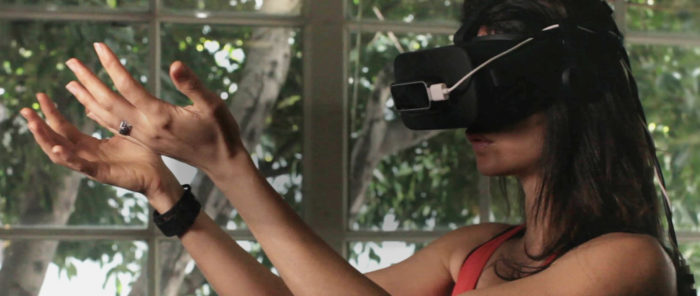Leap Motion CTO David Holz spent more than an hour and a half last Thursday night answering questions about virtual and augmented reality in front of an audience of more than 200 avatars in AltspaceVR‘s virtual environment.
He said that we’re about to see transparent, sunglasses-style virtual and augmented headsets hit the market, and predicted that the next generation of kids will have a dramatically different sense of the world than we do today.

Holz spoke in a form of dark gray floating robot avatar with floating hands that were not connected to his body. Most of the avatars in the room watching his presentation were also creepy floating robots, though a few had a more human appearance.
AltspaceVR offered several ways to attend, including via Oculus Rift, Gear VR, a desktop interface, or via YouTube live stream. I own a GearVR and have used it to attend AltspaceVR events in the past, but the device causes my phone to overheat quickly, and the temperature in my office that day was in the 80s, so I opted for the desktop viewer.
However, I did not spend much time with it because the distance-based sound that AltspaceVR offers, while okay for typical events, meant that the people immediately around me in the audience were much louder than the speaker, and I could barely hear him. Plus, the other avatars, and the disembodied raised hands that indicated audience questions blocked my view. Finally, the sound cut out, and then the speaker disappeared. At that point, I gave up trying and switched to the YouTube view, which was  not only easier to watch and hear, but also offered the additional benefit of a pause button.
The new headsets
The third-generation augmented reality headsets that Holz mentioned will be shaped something like sunglasses and be very lightweight.

The company currently makes a motion controller that can either be used by itself or attached to the front of a virtual reality headset.

In the future, however, Holz expects to see the separate controller disappear, with small cameras built right into the headset. Leap Motion will simply provide the software, he said.
“We don’t really consider ourselves a hardware company,” he said. “We actually mostly do software. Almost all of our engineers are in software. The actual goal is to take this technology and embed it directly into other headsets.”
And headsets won’t just have a single camera, he added. As cameras get smaller, several can be embedded in a headset. These cameras can look up, to the sides, and down to see the user’s lips, hands and feet. They can even be inside the headset, to monitor the user’s eyes.

The cameras can even be stuck on walls, he added, where they will talk to each other, and to headsets, to create an accurate three-dimensional view of the user’s environment. Cameras in the next room over will allow people to be able to look through walls.
Similar cameras in public locations can also be used to allow users to teleport to, say, a street in Paris, in real time.
“It will happen a lot sooner than most people think,” he said.
Other coming changes include transparent headsets.

“They’re slightly funny-colored,” he said. “But they’re pretty reasonable, something that I might wear all day, all the time. And that’s something that, to me personally, is the most exciting. That’s getting into the age of AR.”
The displays of the future will also be able to go from transparent to opaque, for seamless transitions between augmented and virtual reality, and will also automatically adjust the focus.
“As  someone who’s used a lot of these systems behind closed doors, they’re oddly more comfortable,” he said. “There’s something called AR and VR fatigue. As you fix things like focal distance and field of view, the fatigue goes away, and you can actually wear it all day. Your eyeballs are like, ‘Thank you.'”
According to Holz, the virtual reality device companies are working on a lot of things behind closed doors. But while they may not be talking to the public, or talking to each other, they’re all talking to Leap Motion.
“I’m seeing lots of things ahead of everybody,” he said. “Behind the scenes, these things are starting to appear more and more.”
Creepy vision of the future
With mixed reality headsets, we won’t be limited to just our current senses, Holz said.

We’ll be able to see in infrared, ultrasound. We’ll be able to sense electric fields.
“The notion of human senses starts to expand in a weird way,” he said.
Even abstract concepts like quantum waves will be modeled virtually.
“Reality means something very different to the kids,” he said. “They’re going to grow up playing with quantum waves and galaxies, and those things are going to be as natural to them tomorrow as soccer is to us today. It’s not just games. It’s not just entertainment. It’s not just social content. It really changes the fundamental stuff of the world around us and the human experience.”
In addition, better, inexpensive haptic feedback will make it possible for us to feel the virtual objects we interact with. For example, audio and visual effects can create a convincing illusion that you’re actually touching something.
However, walls that we can lean on and chairs that support our weight will require some other kind of technology, such as an exoskeleton, he said.
You can watch the entire presentation in the video below and get the slides here.
- Analysts predict drop in headset sales this year - March 25, 2025
- OSgrid enters immediate long-term maintenance - March 5, 2025
- OSgrid wiping its database on March 21: You have five weeks to save your stuff - February 15, 2025
